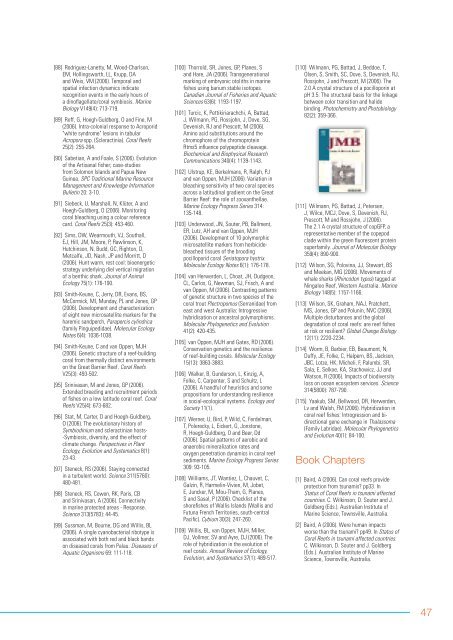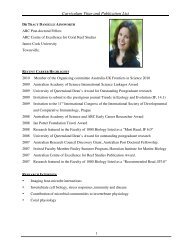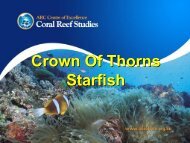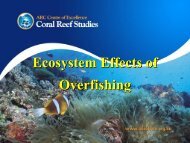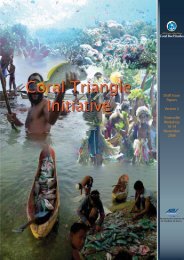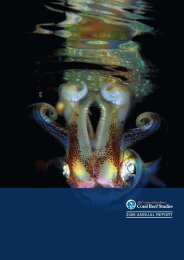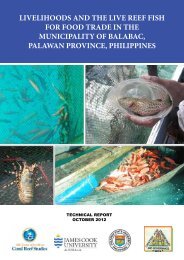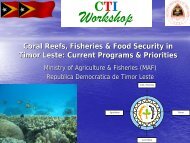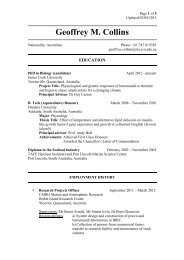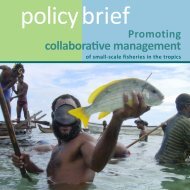Download - ARC Centre of Excellence for Coral Reef Studies
Download - ARC Centre of Excellence for Coral Reef Studies
Download - ARC Centre of Excellence for Coral Reef Studies
Create successful ePaper yourself
Turn your PDF publications into a flip-book with our unique Google optimized e-Paper software.
[88] Rodriguez-Lanetty, M, Wood-Charlson,EM, Hollingsworth, LL, Krupp, DAand Weis, VM (2006). Temporal andspatial infection dynamics indicaterecognition events in the early hours <strong>of</strong>a din<strong>of</strong>lagellate/coral symbiosis. MarineBiology V149(4): 713-719.[89] R<strong>of</strong>f, G, Hoegh-Guldberg, O and Fine, M(2006). Intra-colonial response to Acroporid"white syndrome" lesions in tabularAcropora spp. (Scleractinia). <strong>Coral</strong> <strong>Reef</strong>s25(2): 255-264.[90] Sabetian, A and Foale, S (2006). Evolution<strong>of</strong> the Artisanal fisher; case-studiesfrom Solomon Islands and Papua NewGuinea. SPC Traditional Marine ResourceManagement and Knowledge In<strong>for</strong>mationBulletin 20: 3-10.[91] Siebeck, U, Marshall, N, Klüter, A andHoegh-Guldberg, O (2006). Monitoringcoral bleaching using a colour referencecard. <strong>Coral</strong> <strong>Reef</strong>s 25(3): 453-460.[92] Sims, DW, Wearmouth, VJ, Southall,EJ, Hill, JM, Moore, P, Rawlinson, K,Hutchinson, N, Budd, GC, Righton, D,Metcalfe, JD, Nash, JP and Morritt, D(2006). Hunt warm, rest cool: bioenergeticstrategy underlying diel vertical migration<strong>of</strong> a benthic shark. Journal <strong>of</strong> AnimalEcology 75(1): 176-190.[93] Smith-Keune, C, Jerry, DR, Evans, BS,McCormick, MI, Munday, PL and Jones, GP(2006). Development and characterization<strong>of</strong> eight new microsatellite markers <strong>for</strong> theharemic sandperch, Parapercis cylindrica(family Pinguipedidae). Molecular EcologyNotes 6(4): 1036-1038.[94] Smith-Keune, C and van Oppen, MJH(2006). Genetic structure <strong>of</strong> a reef-buildingcoral from thermally distinct environmentson the Great Barrier <strong>Reef</strong>. <strong>Coral</strong> <strong>Reef</strong>sV25(3): 493-502.[95] Srinivasan, M and Jones, GP (2006).Extended breeding and recruitment periods<strong>of</strong> fishes on a low latitude coral reef. <strong>Coral</strong><strong>Reef</strong>s V25(4): 673-682.[96] Stat, M, Carter, D and Hoegh-Guldberg,O (2006). The evolutionary history <strong>of</strong>Symbiodinium and scleractinian hosts--Symbiosis, diversity, and the effect <strong>of</strong>climate change. Perspectives in PlantEcology, Evolution and Systematics 8(1):23-43.[97] Steneck, RS (2006). Staying connectedin a turbulent world. Science 311(5760):480-481.[98] Steneck, RS, Cowen, RK, Paris, CBand Srinivasan, A (2006). Connectivityin marine protected areas - Response.Science 313(5783): 44-45.[99] Sussman, M, Bourne, DG and Willis, BL(2006). A single cyanobacterial ribotype isassociated with both red and black bandson diseased corals from Palau. Diseases <strong>of</strong>Aquatic Organisms 69: 111-118.[100] Thorrold, SR, Jones, GP, Planes, Sand Hare, JA (2006). Transgenerationalmarking <strong>of</strong> embryonic otoliths in marinefishes using barium stable isotopes.Canadian Journal <strong>of</strong> Fisheries and AquaticSciences 63(6): 1193-1197.[101] Turcic, K, Pettikiriarachchi, A, Battad,J, Wilmann, PG, Rossjohn, J, Dove, SG,Devenish, RJ and Prescott, M (2006).Amino acid substitutions around thechromophore <strong>of</strong> the chromoproteinRtms5 influence polypeptide cleavage.Biochemical and Biophysical ResearchCommunications 340(4): 1139-1143.[102] Ulstrup, KE, Berkelmans, R, Ralph, PJand van Oppen, MJH (2006). Variation inbleaching sensitivity <strong>of</strong> two coral speciesacross a latitudinal gradient on the GreatBarrier <strong>Reef</strong>: the role <strong>of</strong> zooxanthellae.Marine Ecology Progress Series 314:135-148.[103] Underwood, JN, Souter, PB, Ballment,ER, Lutz, AH and van Oppen, MJH(2006). Development <strong>of</strong> 10 polymorphicmicrosatellite markers from herbicidebleachedtissues <strong>of</strong> the broodingpocilloporid coral Seriatopora hystrix.Molecular Ecology Notes 6(1): 176-178.[104] van Herwerden, L, Choat, JH, Dudgeon,CL, Carlos, G, Newman, SJ, Frisch, A andvan Oppen, M (2006). Contrasting patterns<strong>of</strong> genetic structure in two species <strong>of</strong> thecoral trout Plectropomus (Serranidae) fromeast and west Australia: Introgressivehybridisation or ancestral polymorphisms.Molecular Phylogenetics and Evolution41(2): 420-435.[105] van Oppen, MJH and Gates, RD (2006).Conservation genetics and the resilience<strong>of</strong> reef-building corals. Molecular Ecology15(13): 3863-3883.[106] Walker, B, Gunderson, L, Kinzig, A,Folke, C, Carpenter, S and Schultz, L(2006). A handful <strong>of</strong> heuristics and somepropositions <strong>for</strong> understanding resiliencein social-ecological systems. Ecology andSociety 11(1).[107] Werner, U, Bird, P, Wild, C, Ferdelman,T, Polerecky, L, Eickert, G, Jonstone,R, Hoegh-Guldberg, O and Beer, Dd(2006). Spatial patterns <strong>of</strong> aerobic andanaerobic mineralization rates andoxygen penetration dynamics in coral reefsediments. Marine Ecology Progress Series309: 93-105.[108] Williams, JT, Wantiez, L, Chauvet, C,Galzin, R, Harmelin-Vivien, M, Jobet,E, Juncker, M, Mou-Tham, G, Planes,S and Sasal, P (2006). Checklist <strong>of</strong> theshorefishes <strong>of</strong> Wallis Islands (Wallis andFutuna French Territories, south-centralPacific). Cybium 30(3): 247-260.[109] Willis, BL, van Oppen, MJH, Miller,DJ, Vollmer, SV and Ayre, DJ (2006). Therole <strong>of</strong> hybridization in the evolution <strong>of</strong>reef corals. Annual Review <strong>of</strong> Ecology,Evolution, and Systematics 37(1): 489-517.[110] Wilmann, PG, Battad, J, Beddoe, T,Olsen, S, Smith, SC, Dove, S, Devenish, RJ,Rossjohn, J and Prescott, M (2006). The2.0 A crystal structure <strong>of</strong> a pocilloporin atpH 3.5: The structural basis <strong>for</strong> the linkagebetween color transition and halidebinding. Photochemistry and Photobiology82(2): 359-366.[111] Wilmann, PG, Battad, J, Petersen,J, Wilce, MCJ, Dove, S, Devenish, RJ,Prescott, M and Rossjohn, J (2006).The 2.1 A crystal structure <strong>of</strong> copGFP, arepresentative member <strong>of</strong> the copepodclade within the green fluorescent proteinsuperfamily. Journal <strong>of</strong> Molecular Biology359(4): 890-900.[112] Wilson, SG, Polovina, JJ, Stewart, BSand Meekan, MG (2006). Movements <strong>of</strong>whale sharks (Rhincodon typus) tagged atNingaloo <strong>Reef</strong>, Western Australia. MarineBiology 148(5): 1157-1166.[113] Wilson, SK, Graham, NAJ, Pratchett,MS, Jones, GP and Polunin, NVC (2006).Multiple disturbances and the globaldegradation <strong>of</strong> coral reefs: are reef fishesat risk or resilient? Global Change Biology12(11): 2220-2234.[114] Worm, B, Barbier, EB, Beaumont, N,Duffy, JE, Folke, C, Halpern, BS, Jackson,JBC, Lotze, HK, Micheli, F, Palumbi, SR,Sala, E, Selkoe, KA, Stachowicz, JJ andWatson, R (2006). Impacts <strong>of</strong> biodiversityloss on ocean ecosystem services. Science314(5800): 787-790.[115] Yaakub, SM, Bellwood, DR, Herwerden,Lv and Walsh, FM (2006). Hybridization incoral reef fishes: Introgression and bidirectionalgene exchange in Thalassoma(Family Labridae). Molecular Phylogeneticsand Evolution 40(1): 84-100.Book Chapters[1] Baird, A (2006). Can coral reefs provideprotection from tsunamis? pp33. InStatus <strong>of</strong> <strong>Coral</strong> <strong>Reef</strong>s in tsunami affectedcountries. C. Wilkinson, D. Souter and J.Goldberg (Eds.). Australian Institute <strong>of</strong>Marine Science, Townsville, Australia.[2] Baird, A (2006). Were human impactsworse than the tsunami? pp49. In Status <strong>of</strong><strong>Coral</strong> <strong>Reef</strong>s in tsunami affected countries.C. Wilkinson, D. Souter and J. Goldberg(Eds.). Australian Institute <strong>of</strong> MarineScience, Townsville, Australia.47


